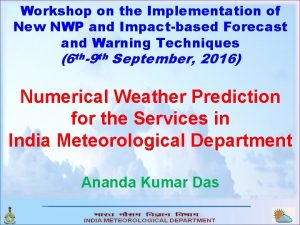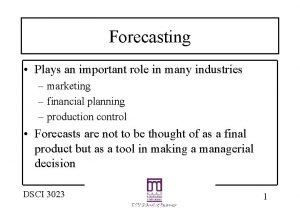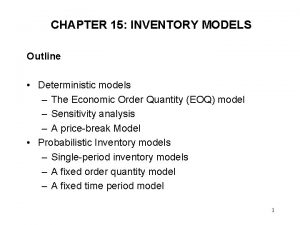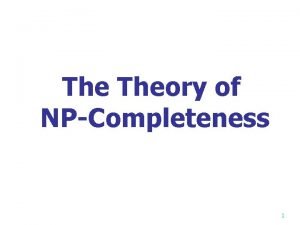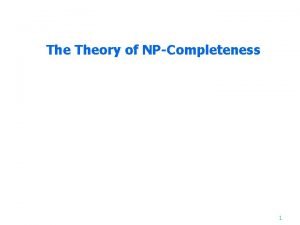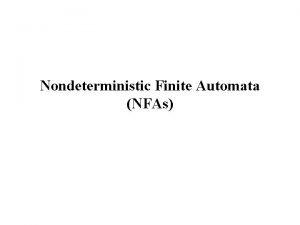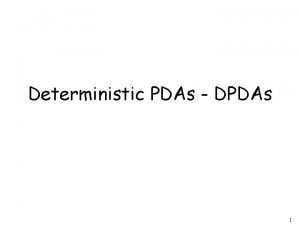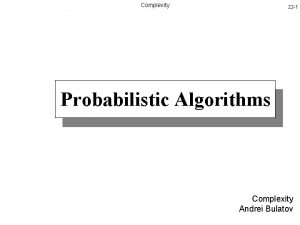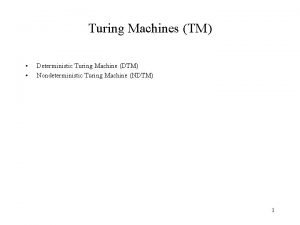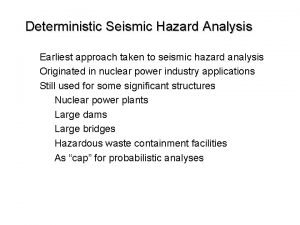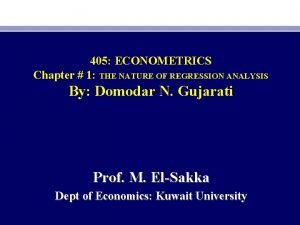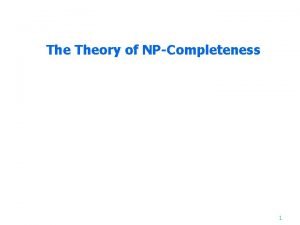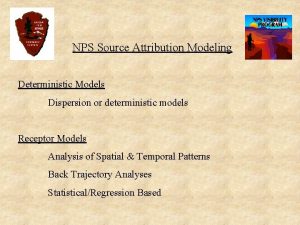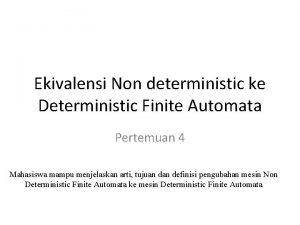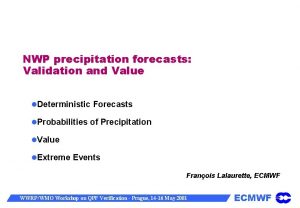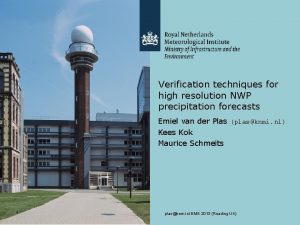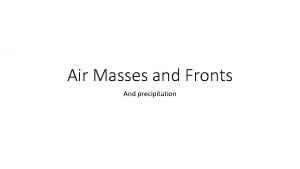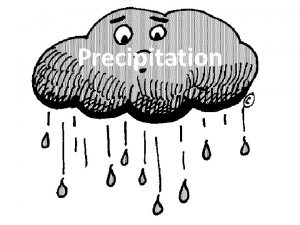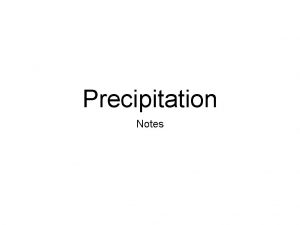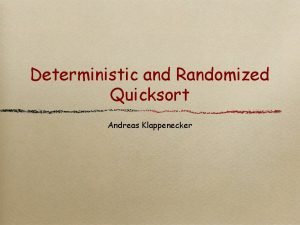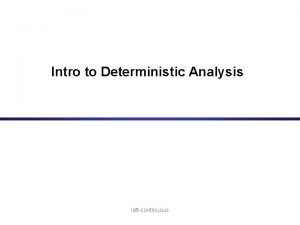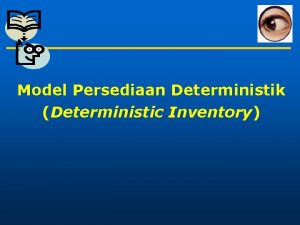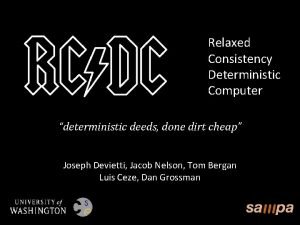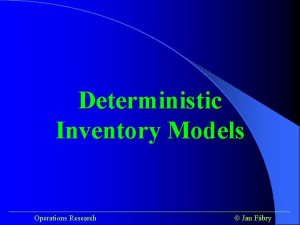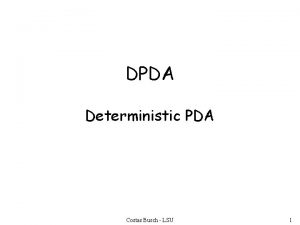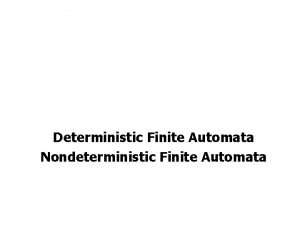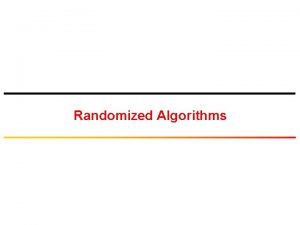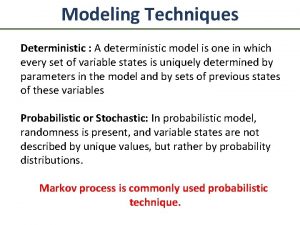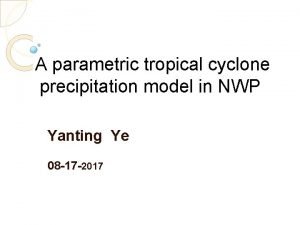NWP precipitation forecasts Validation and Value Deterministic Forecasts



































- Slides: 35

NWP precipitation forecasts: Validation and Value Deterministic Forecasts Probabilities of Precipitation Value Extreme Events François Lalaurette, ECMWF WWRP/WMO Workshop on QPF Verification - Prague, 14 -16 May 2001 ECMWF

Deterministic Verification Deterministic: one cause (the weather today - the analysis), one effect (the weather in n days - the forecast) Verification of the forecast using observations categorical (e. g. verify events when daily rainfall > 50 mm) continuous (needs a definition or norm for errors) » - e. g. (RRforec. -RRobs)2 (Root Mean Square Errors) WWRP/WMO Workshop on QPF Verification - Prague, 14 -16 May 2001 ECMWF

Deterministic Verification: Biases Bias=mean(observation-forecast) Diurnal cycle (too much convective rain by 12 h, too little by 00 h - local time) New microphysics 3 D-var New Physics T 319 4 D-var 60 levels + new precipitation T 511 scheme WWRP/WMO Workshop on QPF Verification - Prague, 14 -16 May 2001 ECMWF

Deterministic Verification: Bias maps (DJF 2001) Overestimation of orographic precipitation WWRP/WMO Workshop on QPF Verification - Prague, 14 -16 May 2001 ECMWF

Deterministic Verification: scatter plots Error distribution WWRP/WMO Workshop on QPF Verification - Prague, 14 -16 May 2001 ECMWF

Deterministic Verification: Frequency Distribution % of days <0. 1 mm 58% 39% Small amounts of precipitation are much more frequent in the forecast than in SYNOP observations WWRP/WMO Workshop on QPF Verification - Prague, 14 -16 May 2001 ECMWF

Deterministic Verification: Heavy rainfall Higher resolution has brought more realistic distributions of heavy rainfall WWRP/WMO Workshop on QPF Verification - Prague, 14 -16 May 2001 ECMWF

Deterministic Verification: Does all this make sense? Synop observations catchment area (raingauge) = O(10 -1 m 2) Model grid catchment area = O(1000 km 2) a large number of independent SYNOP observations per model grid are required for the assessment of the precipitation fluxes in a model grid box. high resolution climatological data - O(10 per model grid box)- are not exchanged in real time, but can be used for a-posteriori verification two studies recently explored the sensitivity of ECMWF verification to the upscaling of observations (Ghelli and Lalaurette, 2000 used data from Meteo-France while Cherubini et al. used data from MAP) WWRP/WMO Workshop on QPF Verification - Prague, 14 -16 May 2001 ECMWF

Deterministic verification: Super-observations Synop data collected from the GTS Climatological network (Météo-France) WWRP/WMO Workshop on QPF Verification - Prague, 14 -16 May 2001 ECMWF

Deterministic verification: Super observations (2) The bias towards too many light rain events is to a large extend a representativity artifact WWRP/WMO Workshop on QPF Verification - Prague, 14 -16 May 2001 ECMWF

Probabilities of Precipitation Po. P can be derived following 2 strategies: To derive the PDF from past error (conditional) statistics (MOS, Kalman Filter) e. g. using scatter diagrams To transport a prescribed PDF for initial errors into the future (dynamical or “ensemble” approach) • ECMWF runs 50 perturbed forecasts at T 255 L 40 (+ 1 control) WWRP/WMO Workshop on QPF Verification - Prague, 14 -16 May 2001 ECMWF

Probabilities of Precipitation (EPSgram) Forecast for Prague, Base time 10/5/2001 12 UTC WWRP/WMO Workshop on QPF Verification - Prague, 14 -16 May 2001 ECMWF

Probabilistic Verification What do we want to verify? Whether probabilities are biased… • e. g. , when an event is forecast with probability 60%, it should verify 6 times out of 10 (no more, no less!) – but then forecasting with the probability=climate frequency is a “perfect” forecast … or whether the probabilistic product is useful • compared, for example, with a single, deterministic forecast WWRP/WMO Workshop on QPF Verification - Prague, 14 -16 May 2001 ECMWF

Probabilistic Verification: 1) Reliability Diagrams WWRP/WMO Workshop on QPF Verification - Prague, 14 -16 May 2001 ECMWF

Probabilistic Verification: 4) Brier Scores BS=(1/N) (p-o)2 p is the probability forecast (relative number of EPS members forecasting the event) o is the verification (=0 if the event did occur, =1 otherwise) the Brier score varies from 0 (perfect, deterministic forecast) to 1 (perfectly wrong, deterministic forecast) the Brier Skill Score measures the relative performance with respect to the climate (for which p=pc, the relative frequency of occurrence in the long term climate) BSS=1 -(BS/BSC) WWRP/WMO Workshop on QPF Verification - Prague, 14 -16 May 2001 ECMWF

Proba. Verification: Brier Skill Scores Time Series 60 levels + new Bugfix precipitation Rnorm - Rnorm+ Stochastic Phys WWRP/WMO Workshop on QPF Verification - Prague, 14 -16 May 2001 T 255 ECMWF

Forecast Value: Brier Scores partition The BS can be split into the sample climate uncertainty, the forecast reliability (BS_REL), and the forecast resolution (BS_RSL): Þresolution tells how informative the probabilistic forecast is; it varies from zero for a system for which all forecasted probabilities verify with the same frequency of occurrence to the sample uncertainty for a system for which the frequency of verifying occurrences takes only values 0 or 100% (such a system resolves perfectly the forecast between occurring and non-occurring events); Þreliability tells how close the frequencies of observed occurrences are from the forecasted probabilities (on average, when an event is forecasted with probability p, it should occur with the same frequency p); Þuncertainty varies from 0 to 0. 25 and indicates how close to 50% the occurrence of the event was during the sample period (uncertainty is 0. 25 when the event is split equally into occurrence and non-occurrence). WWRP/WMO Workshop on QPF Verification - Prague, 14 -16 May 2001 ECMWF

Forecast Value: Categorical Forecasts Categorical forecast - Step 1: event definition e. g. : will rain exceed 10 mm over the 24 h period H+72/H+96? Step 2: gather verification data H=number of good forecasts of the event occurring M=number of misses (no-forecast but the event occurred) F=number of false alarms (yes-forecast of a no-event) Z=number of good forecasts of a no-event False Alarm Rate=F/(F+Z) Hit Rate=H/(H+M) WWRP/WMO Workshop on QPF Verification - Prague, 14 -16 May 2001 ECMWF

Value of Probabilistic Categorical Forecast: Relative Operative Characteristics Forecast of the event can be made at different probability levels (10%, 20%, etc…) P>0 P>10% P>20% WWRP/WMO Workshop on QPF Verification - Prague, 14 -16 May 2001 ECMWF

Categorical Forecast Economic Value (Richardson, 2000) Cost/loss ratio (C/L) decision model can be based on several decision-making strategies: 1. To take preventive action (with cost C) on a systematic basis; 2. To never take action (and therefore facing loss L when the event occurs); 3. taking action when the event is forecast by the meteorological model; 4. taking action when the event occurs (this strategy is based on the availability of a perfect forecast model) WWRP/WMO Workshop on QPF Verification - Prague, 14 -16 May 2001 ECMWF

Categorical Forecast Economic Value (Richardson, 2000) Strategies 1 and 2 can be combined always take action if the cost/loss ratio is smaller than the climatological frequency of occurrence of the event, and not to take action otherwise. The economic value of the meteorological forecast is then computed as the reduction of the expense made possible by the use of the meteorological forecast: WWRP/WMO Workshop on QPF Verification - Prague, 14 -16 May 2001 ECMWF

Categorical Forecast Economic Value (Richardson, 2000) WWRP/WMO Workshop on QPF Verification - Prague, 14 -16 May 2001 ECMWF

Refinements of the EPS verification procedures Address the skill over smaller areas (need to gather several events categories - CRPS) Specifically target extreme events (need climatological data) Refine the references (“Poor Man Ensembles”) Show the ensemble forecast of Z 500 is not more skillful than cheaper alternatives (distributions of errors over the previous year and/or multi-model ensemble) (Atger, 1999; Ziemann, 2000) The ensemble maximum skill seems to be achieved for abnormal situations WWRP/WMO Workshop on QPF Verification - Prague, 14 -16 May 2001 ECMWF

Extreme Events: Recent examples A) November French Floods (12 -13/11/1999) Inches 25 20 15 10 5 150 km WWRP/WMO Workshop on QPF Verification - Prague, 14 -16 May 2001 ECMWF

Extreme Events: November floods TL 319 precip. Acc 72 -96 h TL 159 EPS proba precip. >20 mm (0. 8”) [40, 80]mm >80 mm >5% 1100 km WWRP/WMO Workshop on QPF Verification - Prague, 14 -16 May 2001 >35% >65% ECMWF

Extreme Events: November floods Verification against SYNOP data 0%<p 10%<p 20%<p WWRP/WMO Workshop on QPF Verification - Prague, 14 -16 May 2001 ECMWF

Extreme Events: An EPS Climate 3 years (January 1997 to December 1999) constant horizontal resolution (TL 159) Monthly basis, valid. 12 UTC Europe Lat/Lon grid (0. 5 x 0. 5 - oversampling ) T 2 m, Precip (24, 120, 240 h acc. ), 10 m-wind speed 50 members (D 5+D 10) + Control (D 0, D 5+D 10) around 10, 000 events per month post-processing is fully non-parametric (archived values are all 100 percentiles + 1‰ and 999‰) WWRP/WMO Workshop on QPF Verification - Prague, 14 -16 May 2001 ECMWF

Extreme Events: An EPS Climate (2) WWRP/WMO Workshop on QPF Verification - Prague, 14 -16 May 2001 ECMWF

Extreme Events: EPS Climate (November) 24 h rain rates exceeded with frequency: 1% WWRP/WMO Workshop on QPF Verification - Prague, 14 -16 May 2001 1‰ ECMWF

Extreme Events : Proposals A better definition of events worth plotting e. g. : Number of EPS members forecasting values of 10 m-wind speeds exceeding the 99% threshold in the “EPS Climate” A non-parametric “Extreme Forecast Index”? Based on how far the EPS distribution is from the Climate distribution WWRP/WMO Workshop on QPF Verification - Prague, 14 -16 May 2001 ECMWF

Extreme Events : Extreme Forecast Index • A CRPS-like distance between distributions: • By re-scaling using the climate distribution, we can create a dimensionless, signed measure: • The Extreme Forecast Index is: • 0% when forecasting the climate distribution, • 25% for a determinist forecast of the median, • 100% for a deterministic forecast of an extreme WWRP/WMO Workshop on QPF Verification - Prague, 14 -16 May 2001 ECMWF

Extreme Events: EFI Maps for November Floods WWRP/WMO Workshop on QPF Verification - Prague, 14 -16 May 2001 ECMWF

Extreme Events: Verification issues The proposal is to extend the products from physical parameters • (e. g. amounts of precipitation) to the forecast of climatological quantiles • (e. g. the forecast to day is for a precipitation event that was not occurring more than one time out of 100 in our February climatology) Need local climatologies to rescale the observed values What to do with major model changes? WWRP/WMO Workshop on QPF Verification - Prague, 14 -16 May 2001 ECMWF

Summary Data currently exchanged on the GTS (SYNOP) can only address very crude measures of precipitation forecast performance (biases) or on scales much broader than resolved by the model (e. g. hydrologic basins) High resolution networks are needed to upscale the data from local to model grids; Ensemble forecasts have shown some skill in assessing the probabilities of occurrence in the medium range; an optimum combination of dynamical and statistical Po. P remains to achieve WWRP/WMO Workshop on QPF Verification - Prague, 14 -16 May 2001 ECMWF

Summary (2) Value of probability forecast compared to pure deterministic forecast of precipitation are easy to establish Some idea of extreme events can be found in the model direct output. . . provided it is seen from a model perspective A framework for the verification of these extreme events forecasts has been established, but needs gathering long climatological records from a range of stations WWRP/WMO Workshop on QPF Verification - Prague, 14 -16 May 2001 ECMWF
 As compared to long-range forecasts, short-range forecasts
As compared to long-range forecasts, short-range forecasts Nwp imd
Nwp imd Gravimetry steps
Gravimetry steps Co precipitation and post precipitation
Co precipitation and post precipitation Compare and contrast weather
Compare and contrast weather Contoh value creation adalah
Contoh value creation adalah Weather forecasts lesson 3 outline answers
Weather forecasts lesson 3 outline answers Forecasts play an important role in
Forecasts play an important role in Deterministic demand vs stochastic demand
Deterministic demand vs stochastic demand Is inventory a stock
Is inventory a stock Deterministic and stochastic inventory models
Deterministic and stochastic inventory models Spanning tree of a graph
Spanning tree of a graph Non deterministic algorithm for sorting
Non deterministic algorithm for sorting Non-deterministic algorithm
Non-deterministic algorithm Evaluate social learning theory
Evaluate social learning theory Non-deterministic algorithm
Non-deterministic algorithm Finite automata
Finite automata Dfa ndfa
Dfa ndfa Deterministic vs statistical relationship
Deterministic vs statistical relationship Deterministic games examples
Deterministic games examples Deterministic seismic hazard analysis
Deterministic seismic hazard analysis Pda and dpda
Pda and dpda Non-deterministic algorithm
Non-deterministic algorithm Deterministic operations research
Deterministic operations research Nondeterministic turing machine
Nondeterministic turing machine Known vs unknown environment
Known vs unknown environment Deterministic definition
Deterministic definition Statistical versus deterministic relationship
Statistical versus deterministic relationship Deterministic lockstep
Deterministic lockstep Deterministic game
Deterministic game Deterministic cross device tracking
Deterministic cross device tracking Moore machine
Moore machine Non deterministic algorithm for sorting
Non deterministic algorithm for sorting Deterministic attribution
Deterministic attribution Statistical vs deterministic relationship
Statistical vs deterministic relationship Deterministic finite automaton
Deterministic finite automaton

